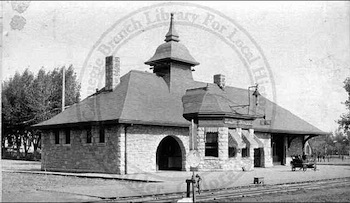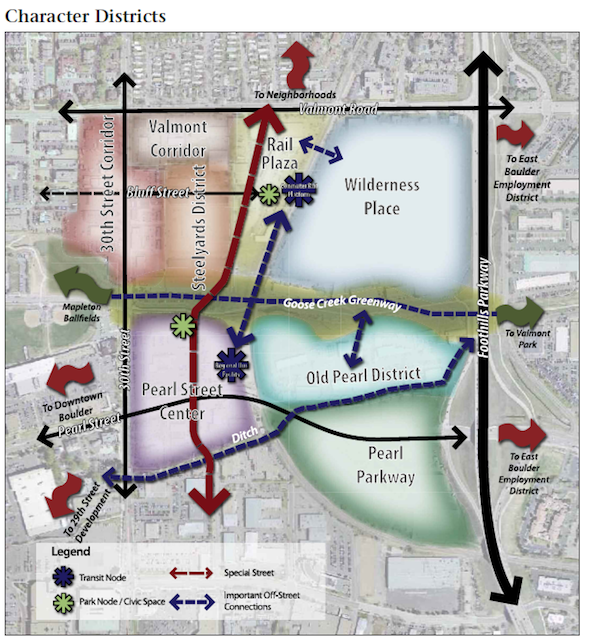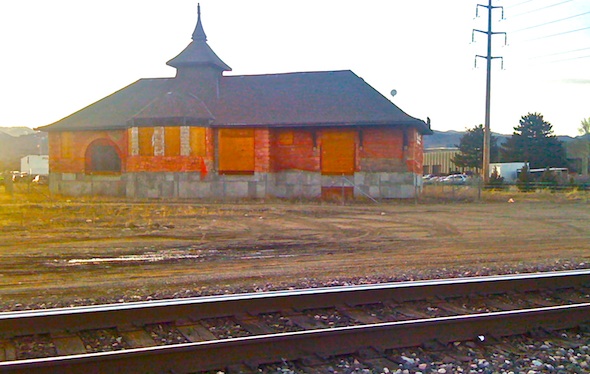DERAILED: The long, troubled saga of the Transit Village
Eric Karnes | Mar 16, 2010
Part I: How We Got Here
In 2004, voters in metropolitan Denver approved a sales tax increase to fund construction of an expanded rail and bus network. For Boulder, the plan included special Bus Rapid Transit lanes on US-36 and commuter rail service to Denver’s Union Station, which will serve as a hub for Denver’s public transportation system.
By 2008, construction had been completed on the light rail lines along I-25 and I-225 in southeast Denver, and work on the line to Golden was beginning. Then the Great Recession struck, resulting in reductions in sales tax revenues as shoppers cut back on their purchases. With a lack of funds pouring into the coffers of the Regional Transportation District, the additional Boulder service was jeopardized.

Union Depot in better days (Photo: Boulder Public Library)
The Boulder City Council decided to take advantage of RTD’s original plans and began a process to develop a plan for a “transit village” around the site of the future rail station and an adjacent bus station. Council members gave vague instructions to City planners, who began to draw up concepts for a large area of East Boulder. Concerns about geographic overreach forced the planners to concentrate their efforts on a smaller and more contiguous area bounded generally by Foothills Parkway, Valmont Rd., Pearl St. and 30th St.
Public participation fades away
In accord with Boulder’s tradition of citizen involvement, planners scheduled numerous meetings to obtain suggestions and comments on the concept. Instead of a plan derived from what the RTD service could do for Boulder, the plan evolved more in the direction of what Boulder could do to generate riders for RTD. The excessive number of meetings simply wore down many members of the public who had been interested in the project. The Transit Village Area Plan became a planner-driven, top-down enterprise.
The Transit Village planning process was somewhat unique in Boulder’s planning experience in that it generated an almost unified front of organizations that found the plan to be unimaginative. These groups, representing business, environmental, design, transportation and neighborhood interests, are often at odds on other issues, but on the Transit Village they saw a great potential opportunity for Boulder degenerate, instead, into a mediocre plan.
However, these groups’ opposition and suggested changes were ignored. City Council, itself worn down by a multiyear, time-consuming process, simply acquiesced and approved the planners’ proposal. The Great Recession then rendered the plan moot for the time being, as developers were unable to build and RTD found itself unable to proceed with the scheduled rail service to Boulder.
Current Council keeps plan intact
But by 2009, concerns about the plan were rising again, including among some of the members of the new City Council majority elected in 2007 and retained in 2009. In February of this year, Council members discussed the concerns over the plan at their annual planning retreat, but subsequently kept the document in place. Part of their willingness to refrain from making changes was a supposed increasing interest by developers in proposing projects in the area plan district.
Part 2: Problems with the Plan
So, what makes the plan so lacking in merit? Consider the issues that arose during the public comments but were ignored by planners and Council:
- There is, as in Gertrude Stein’s famous comment about Oakland, “no there there.” The plan has no “this is Boulder” basis. It could just as soon be a development plan for Longmont, Broomfield or Aurora.
- The advent of RTD service would be a great financial boon to nearby property owners, yet planners steadily, throughout the process, reduced the amount of public space in the plan. Plazas became mini-parks, and the historic Union Depot, once seen as the centerpiece for a grand public plaza at the rail station, was shunted off to an unknown future role. The depot now sits forlorn in a vacant field (see photo above), the epitome of the plan’s deficiencies.
- Planners were unaware of federal regulations governing where passenger stations could be placed on curves and in proximity to railroad lines that carry freight. There were also unresolved issues on passenger platform height and the need for a costly “passing siding” which would take up more space.
- Because planners were unaware of some of the federal regulations about station placement, the original concept of having the RTD rail and bus stations adjacent was scrapped. Instead of facilitating easy transfers between the two modes, the plan as revised has the stations separated by about a third of a mile. Passengers seeking to transfer from bus to rail, or vice versa, would have to walk between the stations — not a situation conducive to maximizing transit use at the Transit Village.
- Probably the worst aspect of the plan is that most of its benefit goes to property owners, not to the public. To make the development process easier, streets were designed to follow existing property lines, rather than placing them where they would function well for users. Public spaces shrank. In return for the benefits they would derive from the redevelopment project, property owners were not required by planners or by City Council to participate in funding appropriate public facilities.
For these and probably other reasons, the Transit Village area plan is now fatally flawed. Rail transit may not come to Boulder as planned in 2015. If voters don’t approve a sales tax increase, it may not come at all — or take decades. Yet the Transit Village area plan will still be in effect, permitting high-density housing and maximizing the financial returns to property owners.
If developed as the plan foresees, Boulder will have, over the next several decades, missed a great opportunity to create a vibrant public place, rail or no rail. Property owners and developers will benefit because Boulder’s public officials were timid when the plan was being adopted. To make matters worse, the timidity lingers on.
Part 3: What Should Be Done?
What is the alternative to the Transit Village Area Plan? Here are some options:
- Plans can be changed. The City Council should at least postpone allowing development that takes advantage of the area plan until the issue of rail transit is resolved, probably by late 2011. If metro voters reject the sales tax increase, it will become highly unlikely that Boulder will get rail service, thereby making the assumptions upon which the plan rests irrelevant.
- If so, the current Transit Village Area Plan should be eliminated and a new process started, this time taking into consideration what can actually be developed in this critical part of East Boulder.
- If, however, the sales tax increase is approved, the plan should still be changed to use the advent of rail transit in 2015 as a catalyst for a creative and imaginative public gateway to the city instead of a development generator.
Over the decades, Boulder citizens have embraced far-reaching proposals like the open space system, building-height limits, balanced transportation, recycling, the Pearl Street Mall and action on climate change. There is no reason now for us to accept such a deficient document as the Transit Village Area Plan.
Junk it.
Eric Karnes is a Boulder-based commercial real estate research consultant to several national clients.
More on the Transit Village
Bob Wells, “Transit Village plan aired, but some aren’t on board,” Boulder Reporter, Feb. 14, 2010
Steve Pomerance, “Pomerance critique of Transit Village plan,” Boulder Reporter, Feb. 14, 2010
City of Boulder, Transit Village Area Plan, Sept 2007 (PDF document, 74 pages)
Pat Shanks, “Transit Village Plan Moves Forward with Council Approval,” The Blue Line, March 8, 2010
“Transit Village 101” (background article), The Blue Line, March 8, 2010

OVERVIEW: This drawing from page 19 of the City’s official “Transit Village Area Plan” of Sept. 2007 shows eight different “character districts” in the development area.


